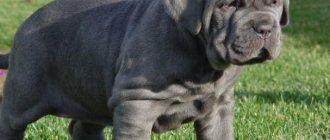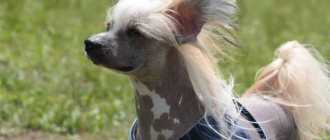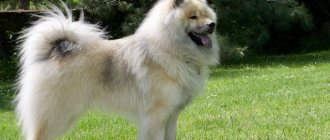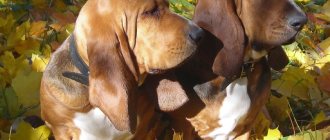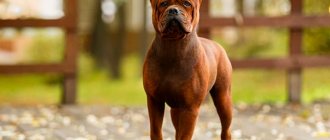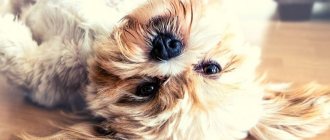Looking at a photo of a basset hound, it may seem that this is the most unfortunate dog in the world. Long dull ears, languid eyes and short stature evoke pity and compassion. A dog with a sad, pleading look immediately wants to be fed and hugged.
In fact, Basset Hounds are very cheerful dogs with a calm, friendly personality. Just pay attention to his long tail. In this breed, it almost constantly sticks up and joyfully moves from side to side, which indicates good health and good spirits.
Description of the Basset Hound breed
Popularity 162nd among 263 dog breeds
Lifespan:
10-12 years
Breed group:
Hounds
Height:
33-38 cm
Country of origin:
France, UK
Average price:
25-35 thousand rubles
Weight:
18-29 kg
Latest articles Cat health
Rabies vaccination for cats: choice of vaccine, necessity, schedule 01/22/2022 4 0 0
Selection and adaptation
TOP 20 best cat breeds for families with children 01/22/2022 25 0 0
Appearance
Description:
- The physique of the Italian Greyhound is graceful. The length and height of its body are almost equal and are about 38 cm. The dog is endowed with a straight back with a slightly rounded loin, a powerful narrow chest that goes into the stomach and strong elongated limbs. The long curved tail allows you to maintain balance on sharp turns. On average, it weighs from 2.5 to 4.5 kg.
- The head of these greyhounds is long and narrow with an elongated, pointed muzzle with dark lips and elongated jaws. The deep-set eyes of the Italian greyhound are dark with an expressive, sincere gaze. Highly set ears become vertical when the dog is alert.
- The coat of Italian Greyhounds is dense, shiny, without undercoat, and fits well to the body. The color of dogs can be black, gray with a blue tint, cream, pastel, white and piebald.
Character and behavior
Italian greyhounds have an affectionate and obedient character. They are devoted to their owner and keenly sense his mood. With an active temperament, they love to be on the move and play with children.
Italian Greyhounds are very smart, insightful and understanding. These character traits contribute to learning the basic commands necessary for hunting and behavior at home. At the same time, they do not tolerate too strict an attitude, which makes them irritated and frightened.
Key facts
According to the characteristics of the breed, the Basset Hound is a hound, has very short legs, good adaptability to terrain, and has an excellent sense of smell. The folds above the eyes give the impression of a perpetually sad mood, but the breed is very cheerful and has great intelligence and loyalty. The male and female are of a fairly muscular build; the size of the Basset Hound is without strong gender differences: the difference in weight rarely reaches 2 kg.
Excellent hunters, devoted companions for their owner, basset dogs require a lot of attention. As a reward, the owner will receive loyalty and the opportunity to watch a real English gentleman every day. Short legs and a good sense of smell made them excellent burrow hunters.
In their homeland, basset dogs are called “couch athletes” due to their powerful, muscular body and desire to lounge on furniture. Periods of activity are replaced by a desire to be a little lazy. Remember: the hunting instinct is not forgotten even in indoor dogs; on the street it will be difficult to distract a dog that is “on the trail.”
The Basset needs a lot of walking, just like any hound. Don't be fooled by its homely appearance - you'll have to spend a lot of time outdoors.
The Basset Hound has a deep and bright voice, and your neighbors will witness this when the dog is left at home alone. Take care not to leave your dog alone for long periods of time.
The description of the Basset Hound breed includes one distinctive feature: extremely high intelligence, and some experts call the Basset Hound one of the smartest dogs.
A long body, a good sense of smell, short legs - all this made the dogs excellent burrow hunters. With them you can go after a hare, fox, badger.
The health and lifespan of a Basset Hound depends on its care. If a dog is not sick with anything, it can live 12 years or more.
History of the origin of the Basset Hound
The basset definitely looks like a British dog; the official homeland in all sources is Great Britain, but in fact the country of origin of the basset hound is France. It was there that the breed was first bred. The history of basset dogs begins in the Middle Ages and has quite interesting facts.
Books, manuscripts, and various illustrations from the Middle Ages in France convey notes about short-legged dogs from the Artesian-Norman hounds. In the 17th century, basset dogs were bred en masse in France.
The breed has received a new qualification. Now they went with them to hunt pheasants, and not just burrow animals. Of course, this was a hunt on foot; it was difficult for a basset to keep up with a horse. But the short legs served their purpose. Where a horse or a large hound could not go, the basset always got through. Shrubs, dead wood, and small ravines were within the capabilities of these hobbits from the world of dogs.
While the nobles were hunting, the commoners were not sitting idle. French peasants fell in love with Basset hounds for their excellent sense of smell and used them in search of truffles.
The breed received further development in Great Britain in the 19th century. Bassets were bred with Bloodhounds, and a local flavor was added in the form of very long ears and an elongated body. The real name Basset Hound appeared (“basset” means “low”).
In Russia, the breed began to develop only in the 70s of the 20th century, although it was originally imported under Peter I. The dogs were bought for a fabulous price, kept in the Izmailovo menagerie, but after the death of the reformer they were forgotten about.
Application
In the past, Basset Hounds were considered ideal dogs for hunting small game: squirrels, raccoons , hares, and rabbits.
Today, hunting talents are in demand much less frequently, but this does not prevent the dog from remaining active and playful.
The owner will have to show athletic qualities, otherwise he risks not keeping up with the pet.
If you are looking for a calmer dog, we recommend checking out the following list:
Basset hound and his shaggy friend are going hunting
The Basset Hound appears to be a lazy introvert, but this is deceptive.
In the fresh air, in the forest, when playing and running, he reveals himself like a real athlete.
His need for an active lifestyle will have to be met 100%.
Appearance of a basset hound
General impression
At first glance at a photo of a basset hound, it seems that what you are looking at is rather a lazy, clumsy caterpillar. Short-legged, with long ears, an eternal mournful expression on the face. Many funny pictures of this breed have circulated online. But…
The dog can experience any emotions, anger, joy, fun, fear, but the expression in the eyes will always show severe sorrow. When running, his long ears flutter so much that it seems as if the dog is taking off. It’s hard to imagine him as a hunter, but the short legs help with this – with them the dog becomes well adapted to the uneven terrain.
Head
Large, elongated, clearly protruding back of the head, parallel lines of the muzzle and skull, cheekbones and cheeks do not protrude, overhanging skin forms wrinkles around the eyes and eyebrows.
Neck
Muscular, long, elongated, well defined dewlap.
Torso
A wide back, withers and croup are located on the same line, the body is strong, muscular, elongated in size, harmoniously developed chest.
Forelegs
Short, strong, strong bones, tightly tucked elbows, slight S-curve allowed.
Hind limbs
Strong, powerful, parallel to each other, rounded hips, low hocks.
Tail
Long, strong, with a slight bend, raised upward when moving.
Movement
Rhythmic, free, not fast, hind and forelimbs are coordinated.
Wool
Short, no fringes.
Color
Usually found in two or three colors. All Basset Hound colors are acceptable for non-breeding purposes.
Size
Dogs have a heavy, elongated body. Basset Hound weight: 18-29 kg. Basset Hound height (height at withers): 33-38 cm. Too much height is grounds for disqualification.
Dachshunds
The origin of the dachshund was noted in the 16th century in southern Germany. Over the centuries, several types of these original dogs have appeared - small in stature on short legs with an elongated body. With all its bizarre external features, the dachshund is a hunting dog with a strong predatory instinct, ready to pursue prey, both in the narrow and long passages of holes, and along the trail of the animal’s blood on the ground.
general characteristics
Description of the breed:
- The Dachshund's physique is characterized by an elongated, muscular body with a protruding sternum and a retracted belly. The longest dachshund in the world reaches 115 cm. The dachshund's legs are short and powerful.
- The dachshund's head has a slightly elongated shape with medium-sized soft and mobile ears, the ends of which are rounded and hang along the cheeks. Expressive oval-shaped dark eyes with arched eyebrows stand out on the muzzle, giving the dog the appearance of a thinking creature. The dachshund has powerful jaws, which is important for a hunting dog.
- According to the color of their coat, dachshunds come in one-color and two-color. The color of one color is considered more valuable: yellow-red, red, pure yellow. Dogs with a two-tone color have a base color of brown or black with tan markings of brown and red or yellow. There are dachshunds with a marbled color.
- The physical characteristics of the dachshund are characterized by strength and mobility. On average, dachshunds live from 12 to 15 years.
Experts classify representatives of this breed by size and type of coat.
Standard fees
Standard hunting dachshunds are dogs with a height of 23 to 27 cm, a chest volume of at least 35 cm and a weight of 7 to 9 kg. The external characteristics of this species correspond to the general characteristics of the breed: a long muscular body on short strong legs, an elongated head shape with a muzzle and color characteristic of the breed.
By their nature, dachshunds are calm, obedient and not picky. They get along well in an apartment and do not need special care. Standard dachshunds have recently been rarely used for hunting, although they are quite trainable. Dwarf and rabbit species of dachshunds were bred for hunting purposes.
Dwarf dachshunds
Miniature dachshunds are much smaller in size than standard ones. They grow from 14 to 21 cm at the withers, depending on the gender of the dog. Their sternum volume is from 30 to 35 cm and their weight is 4-4.5 kg.
The small size of a dog is clearly reflected in its temperament. The dwarf dachshund is a hunting dog by nature. Representatives of this species are much more cunning, meaner and more aggressive, unlike ordinary dachshunds. Their fighting nature, with training, is perfectly manifested in the hunt for burrowing animals. These dachshunds are active, playful, but also touchy, so they need affectionate treatment from their owners.
Rabbit dachshunds
This is the smallest hunting dog of the Dachshund breed, specially bred for hunting rabbits, hares and other small animals in holes with narrow passages. The dog is characterized by the following parameters: height from 10 to 15 cm, chest circumference 30 cm and average weight up to 3.5 kg. This species has a harmonious physique, strong bones and developed muscles. It is characteristic that the front paws of this dachshund are larger and stronger than the hind paws, which is very important during hunting, when the dog has to rake holes filled with earth with its paws.
The rabbit dachshund is distinguished by intelligence, determination, courage and excellent instincts. Hunting is the main calling of her life.
Smooth-haired dachshunds
This variety of dachshund comes from crossing a French Basset Hound with a Pinscher. Representatives of this species have smooth and thick fur that fits tightly to the body. A characteristic feature of smooth-haired dachshunds are skin folds on their paws. This is the very first, oldest variety of the breed with a stocky elongated body, strong, dexterous and agile. The color of smooth-haired individuals is characterized by various shades of red, as well as sable interspersed with wool with black tips.
They are difficult to train, but are easy to educate and do not require special care. By nature, they are protectors, devoted to their owner, and love long walks. Recently, they have rarely been involved in training for hunting.
Longhaired dachshunds
Dachshunds with thick, medium-long hair that lies close to the body, with undercoat and feathering around the ears and on the tail, were bred by crossing a smooth-haired dachshund with a spaniel. The standard coat length is established for dogs when they reach 2 years of age. Then their fur becomes smooth and shiny.
In the southern regions of the country, this type of breed is successfully attracted to hunting. In the rest of the country, long-haired dachshunds are more often purchased as decorative dogs.
Wirehaired Dachshunds
This species is the youngest and comes from crossing a smooth dachshund and a terrier. The wire-haired dachshund differs from its breed in its funny appearance - long hair that lies tightly to the body, especially long in the area of the ears, paws and tail. The appearance of her face resembles an old man with a mustache, thick eyebrows and a beard. The color of wire-haired species of the breed can be varied.
The dog has qualities that are indispensable for hunting: developed ingenuity and intuition.
Basset Hound Personality
Basset is a real aristocrat from Great Britain, a gentleman with a sad face. All this is appearance, but what is different about the personality of a basset hound?
This hunter is very friendly, active, and sociable. The dog is sociable and does not like loneliness. It feels bad at home without its owners, keep this in mind. Great sadness, sadness on the face is just a mask. The breed is cheerful and happy to make contact. Very smart, but moderately willful. Easy to train, provided the correct approach is taken to this gentleman of blue blood.
Children and other animals fit perfectly into the Basset Hound's life. He can even get along with cats. He lives well in an apartment, but at the same time he walks outside with great pleasure. Natural instincts are not forgotten, so be careful on the street. Once a basset gets caught up in someone's scent, it will be difficult to stop him.
The ideal option for an English hunter would be to live in a country house, where this short-legged dog can get plenty of exercise. Reviews from owners describe that even in winter, basset dogs feel good outside without overalls. All thanks to great activity and high-quality undercoat.
If you get a basset hound, give the dog plenty of attention. At home, he wants contact with the owner, otherwise all the neighbors will hear how loud your dog barks and howls. He does not accept privacy.
The difficulty lies in his stubbornness: when he wants to do something, he will do it, and it will be difficult to convince him. For example, the basset loves to lie on something soft, so rest assured: while you are at work, he will definitely sleep on your bed. A love of sofas and beds is a distinctive feature of the breed.
A basset puppy will charm you with its appearance and long ears, it will be affectionate and active, but an adult dog will be distinguished only by some waywardness. Who is the Basset Hound suitable for? An active person who lives in one place and also has the patience to communicate with a funny stubborn person.
Socialization
It will take a long time for a Basset Hound to be socialized. It's like a baby. The best time for house training is from 12 weeks of age. At this point, the puppy’s psyche becomes more stable, and he is ready to change his usual lifestyle. Without socialization, it is impossible to develop a self-confident person.
Meeting other dogs begins in the puppy area, with puppies of the same age. If the baby is kept at home all the time and not allowed to contact other animals and people, then the dog can grow up withdrawn, cowardly and aggressive.
There is a tolerant attitude towards animals living in the same territory. Cats interest him as a hunting object only when walking. If there are small children of preschool age in the family, then they will grow up together. Together they will bully, make friends and find common activities. In this case, the dog will be attached to its little owner.
Of all its brothers, the basset will unmistakably choose a representative of its breed for games and communication.
Education and training
The question all owners ask. How to raise a dog so that it grows up to be an easy-going four-legged friend? The Basset Hound is an interesting, sociable breed, but at the same time it knows how to stand its ground and protect its interests. Take this feature into account when you begin raising and training your Basset Hound.
Command training should be carried out by a specialist or experienced dog breeder. You don't need to put a lot of pressure on the basset, you just need to find the right approach. Observe your pet, try to understand it.
Yes, he can carry out commands less clearly than a guard dog, constant comments will periodically irritate him. But if the training is organized correctly, the basset can greatly succeed in training.
Successful training cannot happen without a good incentive. Food is an excellent “engine of progress” for the basset hound. Just be careful not to overfeed this smart beggar. Otherwise, he will be very trained and at the same time incredibly fat.
Each exercise and lesson should not exceed 10 minutes, otherwise the dog will get tired. Accustom your basset not only to commands: he must get used to being alone for a while. Leave him alone for an hour at first, then increase the interval.
How to wean a puppy and an adult dog from collecting different things? Yes, he loves it, collecting slippers and various objects in a pile. There is no definitively successful solution to recommend. Keep valuables away as far as possible. If you notice that your pet chews furniture, shoes, or spoils things, try to buy new dog toys that he can chew without restrictions.
How to train a basset hound to go to the toilet regularly? The usual standard method will do: take the puppy outside after feeding. If he came from the street without results, go again after 5 minutes. Basset must understand that the job must be done.
If the floor is covered in puddles despite all your efforts, consider whether there is a place for injustice. The breed is touchy and knows how to do dirty tricks out of spite.
Is it possible to punish a basset hound? No, he shouldn’t, he will only hide in thoughts, then try to take revenge. Be an older friend and teacher; the dog will not want to tolerate a serious supervisor.
What time of year can you train a basset hound outside? In any case, in summer and spring it’s comfortable in any case. In winter, the Basset is not afraid of cold weather due to its thick undercoat. In the fall, especially in the rain, wear overalls. The dog loves to roll in the mud.
Popular shades
Tricolor : black and reddish-fawn spots located on a white background. If black predominates, then this color is called saddleback, and if white, then shiny. Black and red, interspersed, are called variegated color.
Bicolor : with this color, spots of lemon, red, red or even chestnut shades are located on a white background. Black and white bicolor is also found, but extremely rarely, since black color is not typical for this breed.
White : According to the breed standard, pure white is acceptable, but there should be no signs of marking, although marking is not considered a fault in other colors.
Black : Extremely rare and usually combined with small white markings.
In general, any color typical of hounds is considered acceptable for beagles, with the exception of chocolate, also called liver.
Basset Hound Health and Diseases
Possible diseases
Basset Hounds have fairly good health. The breed is very hardy. However, heredity has endowed them with some characteristics, which sometimes result in complex diseases.
If there are alarming signs, you should contact your veterinarian immediately.
This will help prevent serious illnesses. Like all dogs, vaccinations must be carried out on time. Frequent diseases of Basset hounds:
- von Willebrand disease;
- otitis;
- skin diseases;
- eye diseases;
- dysplasia of the hip and elbow joint;
- allergies to food components and plants;
- interdigital cysts;
- intestinal volvulus.
What are these diseases associated with and what treatment is required?
Blood clotting problems, or von Willebrand's disease, are hereditary in Basset Hounds. It must be remembered that any injury has a risk of death. A blood plasma transfusion can help. If the diagnosis is confirmed, the dog is removed from the breeding program.
Often joints in dogs suffer (this is dysplasia). Pathology is poorly detected at an early stage. Only when the dog begins to pay attention to its paws does the owner notice the problem. Full recovery does not occur; the course of the disease can only be successfully stopped.
Due to overhanging folds of the eyelids, the eyes suffer: glaucoma, conjunctivitis, cataracts, and deformation of the eyelids appear. When eye diseases are detected, the breeding work of the dog is called into question.
Obesity is a problem for all Basset Hounds; the breed has a high tendency to be overweight. A proper, balanced diet and active walks will be excellent prevention. A quiet apartment life will definitely add extra weight to your pet.
As the owner of long ears, the dog has to deal with infections more often than others. Clean your pet's ears frequently and diligently.
Difficulty breathing through the nose, sneezing, nosebleeds are obvious symptoms of an inflammatory disease. The most common is rhinitis (runny nose). Most dogs suffer from tartar and other oral diseases, and Basset Hounds are no exception. Check and brush your teeth as often as possible. Let bleeding gums, an unpleasant odor, and caries alert you.
The Basset, like any other dog, must be vaccinated against hepatitis, rabies, trichophytosis, distemper, parainfluenza, and leptospirosis.
Reproductive health
The first heat of a Basset Hound begins at the age of 6-12 months, lasts about 20 days, sometimes up to a month, with a frequency of 7-9 months. The main signs of the onset: the bitch began to often ask to go to the toilet, aggressive, tired, asking to eat and drink more.
Pregnancy can be determined four weeks after mating. Labor begins after 58-65 days. The first birth process for a bitch is very nervous, she does not understand what is happening and what needs to be done, it can damage the puppies. It is recommended to accompany the birth of babies.
Neutering for beagle dogs is usually a controversial issue. The owners are afraid of deterioration in hunting qualities. If you do decide, it is recommended to consult with your veterinarian about the appropriate age for surgery.
Pros and cons of mestizos compared to purebreds
Compared to purebred dogs, mestizos are more resistant to various diseases. They are not prone to hereditary diseases. But this does not mean that a mestizo cannot acquire an illness throughout his life. They also need care, proper nutrition and care.
Veterinarians and geneticists have found that puppies inherit the most positive qualities of their parents. For this reason, hybrids are often smarter than purebreds. Mestizos have an extraordinary appearance, so they often take part in exhibition events.
Hybrid dogs are characterized by an unpretentious diet, good watchdog qualities, and rapid adaptation to an unfavorable environment.
Mixed breeds are sold very cheaply because they are not considered very valuable. They are often given away for free.
Hybrid puppies also have negative properties. Such animals can have an overly explosive, nervous, and aggressive character. There are cases where hybrid guard dogs are difficult to train and uncontrollable; they have to be trained for a long time.
Did you know? The English mastiff Zorba is considered the largest dog in the world. This dog was born in 1981. He weighed one hundred and fifty-five kilograms and his body was a centimeter long.
Features of feeding and diet
How to feed this funny puppy? The Basset Hound is a fast-growing breed, so the puppies' diet should be nutritious from the first months. You need to decide what the food will consist of, decide what to feed throughout your life.
How many times should you feed your baby? Here it is worth sticking to the standard schedule and taking age into account. At the age of up to 2 months - 6 times, 2-3 months. – 5 times, 4-6 months – 4 times, 6-12 months – 3 times, after 1 year – 2 times.
How much to feed, what serving size is optimal? The dog has a good appetite, but large portions are not needed. All standards can be viewed in the dog breeding table. Think in advance about what the feeding will consist of.
It is advisable to think over a monthly diet (if the dog does not eat dry food). This will make it easier to understand how balanced your dog’s diet is. Is it possible to serve food from a common table? The Basset should not eat confectionery, sausage, fatty meat, legumes, fried foods, potatoes, radishes.
Suitable for daily nutrition:
- beef;
- rabbit;
- turkey;
- rice and buckwheat porridge;
- steamed millet;
- cottage cheese;
- fermented baked milk;
- kefir.
After consulting with your doctor, you can add vitamin and mineral complexes. Fresh drinking water should always be available.
When it comes to drying, which food is right for your dog? You'll have to experiment a little, but experts advise choosing food from more expensive brands. Quality nutrition is the key to good health. Chat with dog breeders on forums, read reviews, it will be easier to choose.
Mating
Before breeding, both male and female dogs need to be tested for infections. At the time of the first mating, the dog must be at least one and a half years old.
Before mating, it is necessary to check that the bitch has all routine vaccinations. Only in this case will the puppies be reliably protected from such dangerous diseases for dogs as plague and rabies. A bitch is not allowed to breed more than once a year. The last pregnancy is allowed at 6-7 years of age.
The first mating of a male dog takes place with the help of an instructor. The second and subsequent ones - without human intervention.
Care and maintenance
Caring for and maintaining a Basset does not require special procedures or expensive purchases; the breed is quite clean. A standard set (bowls, leash, collar, toys) will be enough.
The Basset's coat is short and harsh. Molting is noticeable in autumn and spring. It is better to brush your hair daily: a brush with natural bristles is suitable for this. Washing will save you from the unpleasant odor. Bathe your dog 2 times a month using suitable shampoos.
Due to the folds on its muzzle, the Basset Hound is prone to slobbering. Don't be surprised, you'll have to wipe off the drool often. After walking and feeding, remove saliva with a towel. Bassets also know how to drink water so much that they splash it all over the floor.
How to care for long ears? Remember: the ears are the weak point of the breed; they need to be cleaned, washed, and even ventilated often. This will prevent the occurrence of infections. You can watch the video if you are not sure or are afraid of harming your dog’s ears.
Teeth and oral cavity should be regularly examined and cleaned with a special brush. The dog will resist, but the procedure is necessary. It is better to teach it from puppyhood.
The nails need to be trimmed a couple of times a month, otherwise you will hear the basset hound clattering quite loudly on the floor. Due to drooping eyelids, inflammation in the eyes is likely; do not forget to treat the eyelids with a cotton pad with chamomile infusion. The procedure is simple, but it will avoid the development of an eye infection.
If your dog is participating in a show, wash it two days before the event. Use shampoo with oil. Brush your teeth with a special brush, trim your nails a few days in advance and treat them with a nail file.
Of course, the Basset is not a long-haired dog, he does not need a haircut or endless scratching. But removing fleas and ticks, combing fur during shedding, and treating claws are mandatory.
Tips for choosing a puppy
How to choose a healthy puppy with a good pedigree? If you are buying a dog for the first time, you will need to consult an experienced specialist.
Visit exhibitions in advance and talk to professional breeders. Contact the breed club, they will advise you on trusted nurseries. Inspect multiple litters at once so you can compare Basset Hound puppies.
Touch the puppy's tail; if there are kinks or bends, this will be considered a serious defect. The paws should be thick and even. Carefully inspect the ears, wax, plugs, and there should be no unpleasant odor. Observe the puppy’s behavior, how active he is, what his appetite is, and whether he is very timid. If you notice deviations, the price of the puppy should be lowered.


